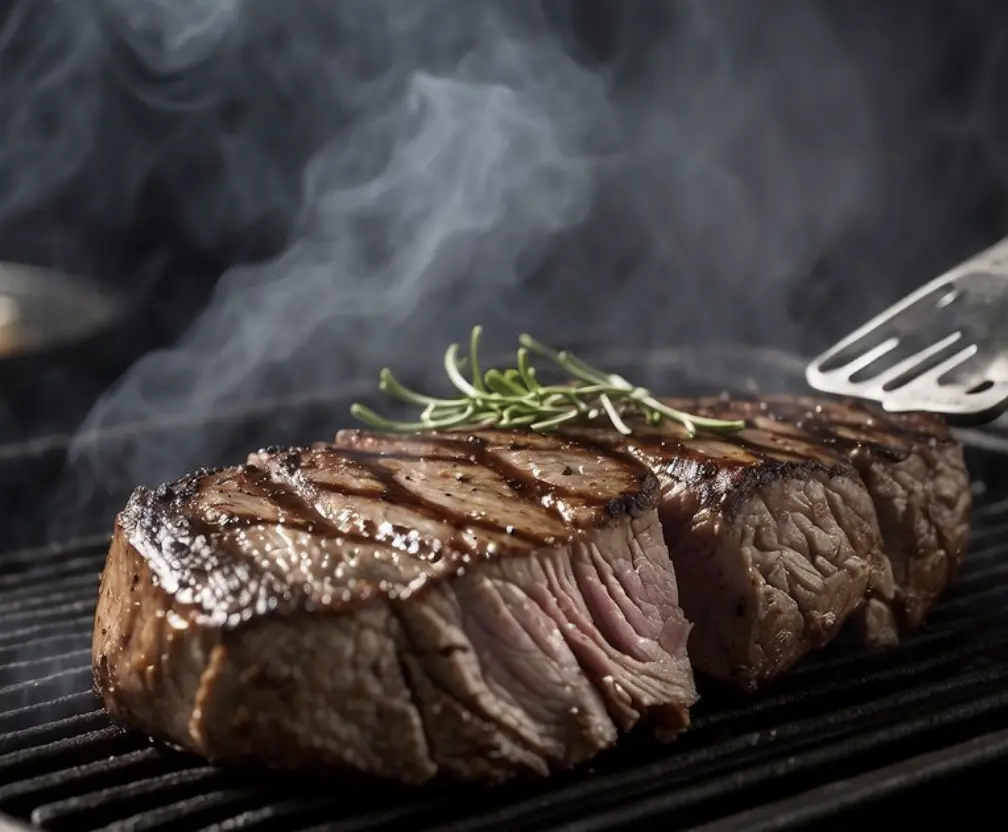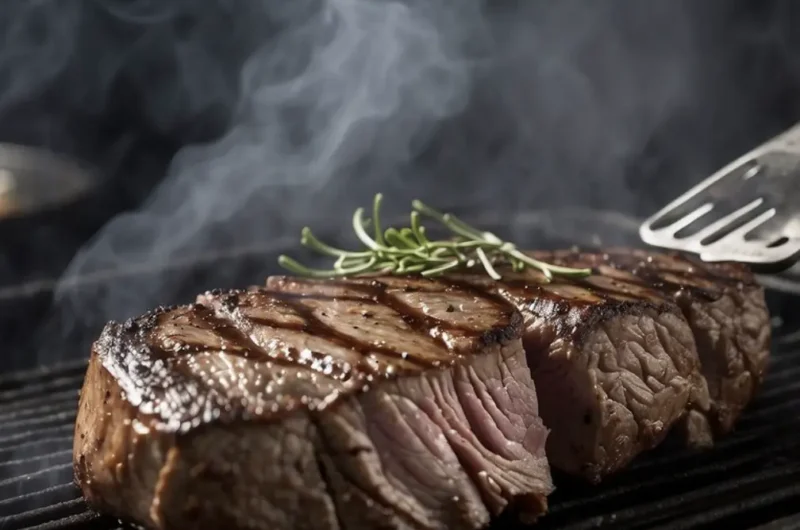Cooking steak to that perfect medium doneness is a skill I’ve honed over the years, and using a George Foreman Grill can make the process surprisingly simple. The dual contact with the heated plates enables the steak to cook evenly and quickly. So, how long to cook steak on George Foreman Grill for medium doneness? From my experience, a steak that’s about 1-inch thick is ideal for achieving a medium cook without ending up too dry or too rare. The key to success lies in preheating the grill and knowing exactly how long to cook the steak.

Timing is critical, as even a minute too long on a George Foreman Grill can change your steak’s level of doneness. Typically, for a medium cook on a 1-inch thick steak, I’ve found 6-8 minutes to be the sweet spot. This range is enough to cook the steak through while still maintaining a juicy center. However, I always recommend using a meat thermometer to check and see that the internal temperature reaches 145°F, the temperature indicative of a medium-cooked steak. It’s a foolproof way to get consistently good results.
I also suggest allowing the steak to rest after grilling, a step that many overlook. A few minutes of rest time lets the juices redistribute throughout the steak, ensuring that each bite is as flavorful as the last. Through trial and error, I’ve learned it’s not just about the cook time; the entire process from preparation to plating is important to master for that satisfying medium steak on your George Foreman Grill.
Selecting the Right Cut
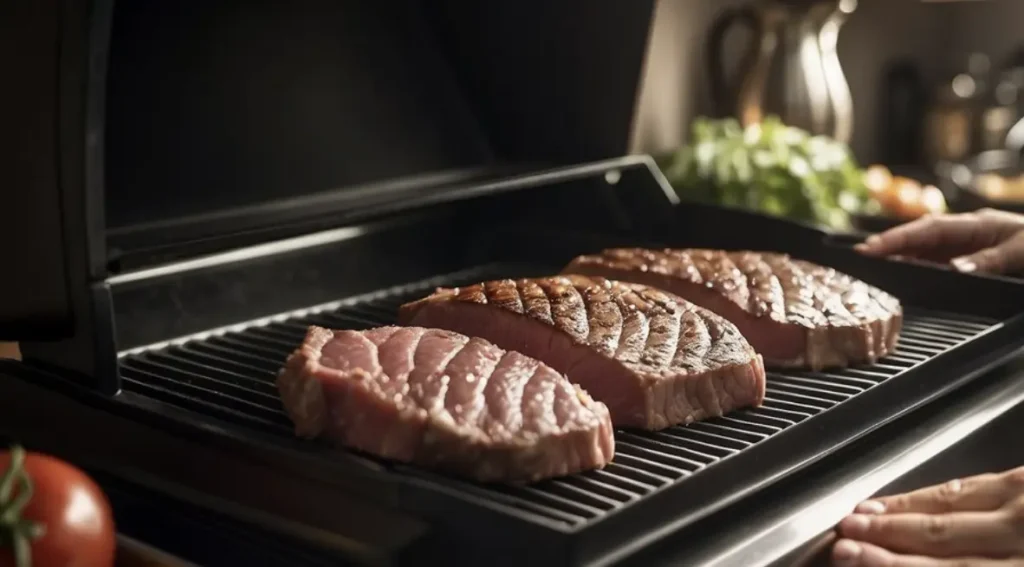
When I’m aiming for that perfect medium steak on my George Foreman grill, starting with the right cut of beef is crucial. It’s not just about flavor, but how the steak will cook on the contact grill. Thicker cuts tend to fare better as they can develop a nice exterior sear while still achieving a medium level of doneness inside. Keep in mind that the thickness of you meat will impact how long you need to cook your steak on a George Foreman Grill to achieve a perfect medium level.
Identifying Quality Steaks
I always look for steaks with a good balance of marbling—those little white flecks of fat throughout the meat. This fat melts during cooking, giving the steak more flavor and juiciness. Ribeye steak and New York strip steak are excellent choices due to their marbling and tenderness. The color of the steak should be a bright cherry red, indicating it’s fresh.
Understanding Steak Cuts
The best steaks for grilling, especially for achieving a medium doneness, are often around 1 to 1.5 inches in thickness. Filet mignon steaks, known for their tenderness, are a fine option. But, remember, their lower fat content means I need to be careful not to overcook them. Then there’s the T-bone steak, which essentially gives me two kinds of steaks in one—a taste of the tenderloin and the strip. Sirloin steak is a more affordable option, offering robust flavor, too.
Preparation for Grilling
Preparation starts with bringing my steak to room temperature, ensuring it cooks evenly. Lightly oiling the steak and seasoning it with salt can enhance its natural flavors—especially important for beef tenderloin or prime rib roast, which are leaner cuts. I avoid using thick marinades as they can hinder the grilling process, potentially causing the steak to cook unevenly or stick to the grill.
Setting Up Your George Foreman Grill
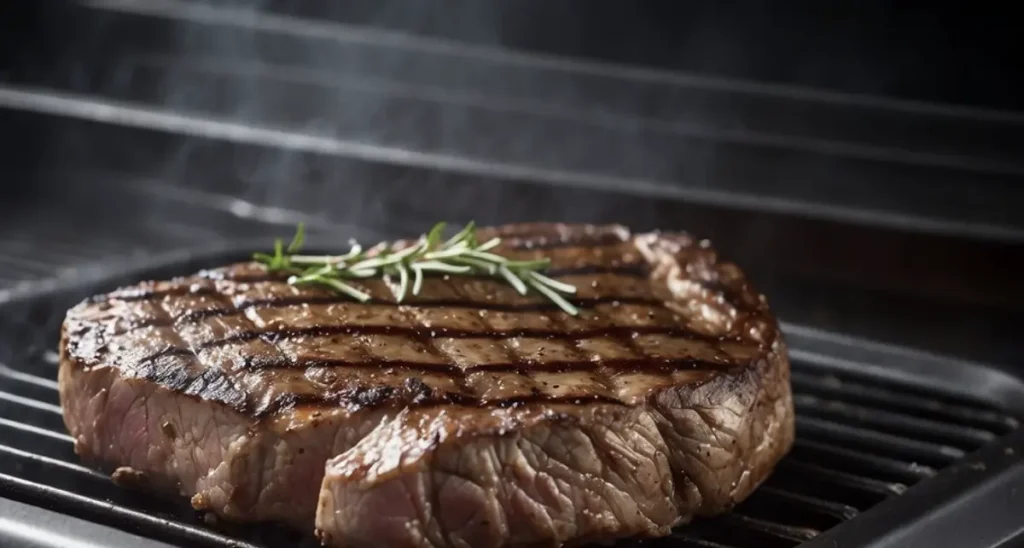
Before cooking a steak to medium on my George Foreman grill, I ensure the grill is properly set up for the best results. This involves preheating, arranging the drip tray, and setting the temperature correctly.
Preheating the Grill
I always preheat my George Foreman Grill for at least 5 minutes before cooking. This is an essential step to achieve even cooking and the desirable sear on the steak. For steak, I use the high setting to mimic the intense heat of an outdoor grill.
Arranging the Drip Tray
Positioning the drip tray correctly is vital to manage the grease. My George Foreman Grill came with a custom-fit drip tray that slides snugly under the edge of the grill. I make sure it’s placed properly to catch the runoff and keep my countertop clean.
Optimal Grill Temperature Settings
For a perfect medium steak, the electric grill needs to be hot. When I cook steak to medium, I always set my George Foreman Grill to the high setting, gauging that the temperature is right when droplets of water sizzle on the grill plates. Occasionally, I’ll brush the plates with a little olive oil for extra flavor and to prevent sticking, despite the non-stick coating on my indoor contact grill.
Steak Grilling Techniques
When I prepare steak on my George Foreman grill, it’s important to focus on proper seasoning, grilling times, and techniques to achieve the perfect level of doneness. I follow specific steps to ensure each steak turns out flavorful and cooked precisely to my desired doneness.
Seasoning the Steak
Before placing the steak on the grill, I ensure it’s well-seasoned. A sprinkle of salt and black pepper is enough, but for a bolder taste, I sometimes add garlic powder, onion powder, or my favorite herbs. It’s important not to over-season, as the flavors intensify during grilling.
Grilling Times and Techniques
When it’s time to grill, I preheat my George Foreman to high heat for at least 5 minutes to sear the steak properly. For a medium steak, I follow the recommended grilling times:
- Steaks 1/2 inch thick: 4-7 minutes
- Steaks 3/4 inch thick: 5-7 minutes
- Steaks 1 inch thick: 6-9 minutes
Use a digital meat thermometer to see if it reaches the desired temperature — 145°F for medium. The total time may vary slightly based on the cut and initial temperature of the steak.
Achieving the Perfect Doneness
Achieving the perfect doneness is crucial. I keep a close eye on the steak as it cooks and check the internal temperature with the digital meat thermometer halfway through. Steaks should reach 135°F for medium-rare and 150°F for medium-well. After removing the steak from the grill, I let it rest for a few minutes to redistribute the juices and ensure a succulent bite.
Enhancing Flavor and Presentation

When cooking on a George Foreman grill, I know that incorporating savory marinades and carefully chosen finishing touches can significantly elevate the dish’s flavor profile and visual appeal. My aim is to guide you through optimizing these aspects for a more enjoyable eating experience.
Marinades and Rubs
Marinating beef steak infuses it with robust flavors and can tenderize the meat. I typically use a mixture of soy sauce, Worcestershire sauce, and balsamic vinegar to create a complex taste. For a hint of smoky flavor without the grill, try a few drops of liquid smoke to the marinade. Here’s how I do it:
- Place the steak in a Ziploc bag.
- Pour the marinade over the entire steak, ensuring all sides of the steak are well-coated.
- Seal the bag and let it chill out in the refrigerator for at least 30 minutes or overnight.
Alternatively, a dry rub with black pepper, sea salt, and other spices massaged onto the meat can also create a delicious crust. I make sure to pat the steak dry with a paper towel so it is not moist before applying the rub to ensure it sticks well.
Adding Finishing Touches
Right before serving, I add a few final touches to my steaks for that restaurant-quality look and taste. A simple drizzle of red wine vinegar or a dab of herb butter can provide a bright contrast to the rich flavors. Here are the steps to achieve this:
- Rest the steak: After grilling, I let the steak rest on a plate for a few minutes. This allows the juices to redistribute.
- Finishing touches: Spooning over a bit of the resting juices or some prepared sauce right before plating adds an extra layer of flavor and a glossy sheen.
When it comes to serving, I often lay the steak next to favorite side dishes like roasted sweet potatoes to complement its heartiness. The combination of well-marinated meat, a perfectly seared exterior, and a touch of acid makes for a steak that’s beautiful to behold and delectable in taste.
Post-Grilling Tips and Serving
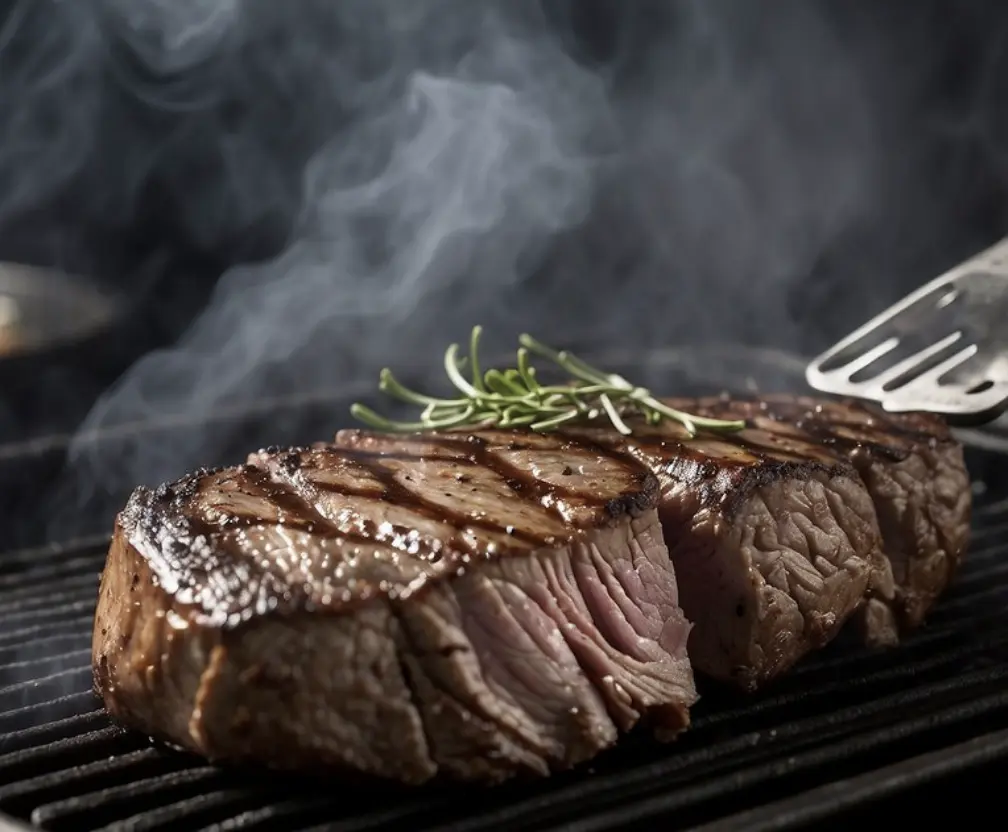
After carefully removing my steak from the George Foreman grill, I know the journey to a perfect steak isn’t quite finished. To ensure I’m serving the most flavorful and delicious steak possible, there are some crucial steps I always follow post-grilling.
Resting the Steak
I always let my steak rest on a large plate for about 2-3 minutes. This allows the juices to redistribute, ensuring every bite is succulent. I make sure the steak is off to the side, away from the heat of the grill while it rests. It’s important not to cover the steak too tightly as I want to avoid steaming it.
Accompaniments and Side Dishes
While the steak is resting, I like to prepare my side dishes. My go-to selections are options that complement the rich flavors of the meat. I might drizzle olive oil in a small bowl for a simple dipping sauce or prepare a light salad. Grocery stores offer plenty of side dish options, but I find fresh, homemade sides pair best with steak. I’m mindful to trim any excess fat before serving, for a clean presentation on the plate.
Frequently Asked Questions
In this FAQ section, I’ll clarify common inquiries about cooking times and methods for preparing steak on a George Foreman grill.
What is the recommended cooking time for a 1-inch steak on a George Foreman grill?
For a steak that is approximately 1-inch thick, I find it best to cook it for about 4-6 minutes if you aim for a medium finish.
How do I determine the cooking duration for different types of steaks such as ribeye or sirloin on a George Foreman grill?
The cooking time for steaks like ribeye and sirloin may vary based on thickness and personal doneness preference. Generally, a ribeye steak cooks in about four minutes per side on a preheated grill for medium doneness.
At what temperature should steak be cooked on a George Foreman grill for optimal results?
The grill should be preheated to a high temperature, often indicated by the grill’s ready light, to ensure thorough cooking and to achieve the desired sear on the steak.
What are the specific time guidelines for cooking a steak to a well-done level using a George Foreman grill?
If you prefer your steak well-done, it’s recommended to cook it for about 6-7 minutes depending on the steak and grill model.
Can you provide some tips for grilling steaks to medium doneness on a George Foreman grill?
To achieve medium doneness, preheat the grill and cook the steak for approximately 5-6 minutes. Using a meat thermometer to check for an internal temperature of 160°F can ensure a medium finish.
Is it effective to use a George Foreman grill when cooking steaks, and if so, how does it affect the flavor and texture?
Yes, using a George Foreman grill can be effective for cooking steak. It tends to cook more quickly and can reduce fat content by allowing grease to drain, which may result in a different texture and flavor compared to traditional grilling.
New York Strip Steak Dinner For Two
Course: DinnerCuisine: AmericanDifficulty: Easy2
servings1
hour10
minutesThis easy steak dinner is flavor-packed with a smoky marinade and tender meat.
Ingredients
2 New York strip steaks
1/4 cup soy sauce
2 tablespoons olive oil
2 cloves garlic, minced
1 teaspoon smoked paprika
1/2 teaspoon black pepper
1/2 teaspoon onion powder
1/2 teaspoon liquid smoke (optional for extra smokiness)
Directions
- In a small bowl, whisk together the soy sauce, olive oil, minced garlic, smoked paprika, black pepper, onion powder, and liquid smoke (if using) to create the marinade.
- Place the New York strip steaks in a shallow dish or resealable plastic bag and pour the marinade over them, making sure the steaks are well coated. Cover the dish or seal the bag and refrigerate for at least 1 hour, or overnight for best results.
- Preheat your indoor grill (such as a Foreman grill) to high heat.
- Remove the steaks from the marinade and let any excess drip off. Discard the remaining marinade.
- Place the steaks on the preheated grill and cook for 4-5 minutes for medium-rare, or adjust the cooking time to your desired level of doneness.
- Once cooked to your liking, remove the steaks from the grill and let them rest for a few minutes before serving.
- Serve the New York strip steaks with your favorite sides and enjoy your delicious, smoky grilled meal!
Nutritional Information Per Serving
| Nutritional Component | Amount per Serving |
|---|---|
| Calories | 280 kcal |
| Total Fat | 14 g |
| Saturated Fat | 6 g |
| Cholesterol | 80 mg |
| Sodium | 520 mg |
| Total Carbohydrates | 2 g |
| Dietary Fiber | 0 g |
| Sugars | 1 g |
| Protein | 35 g |
